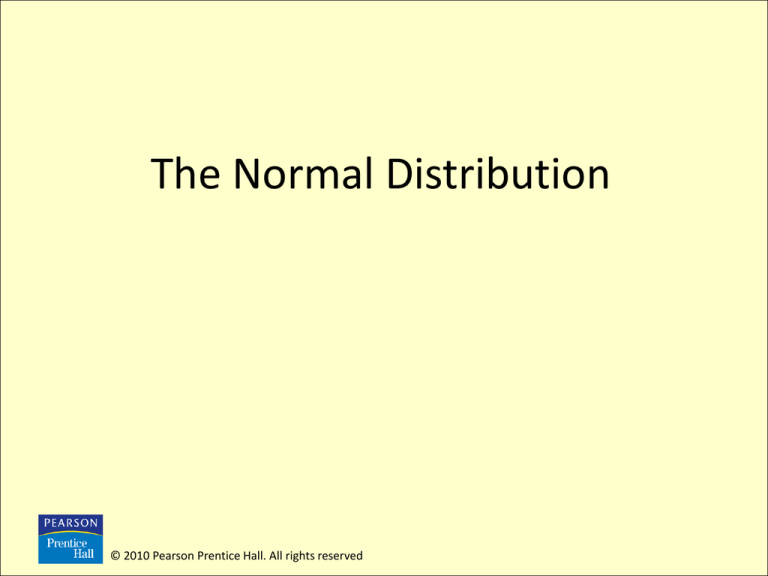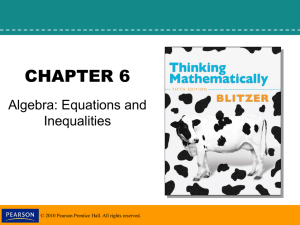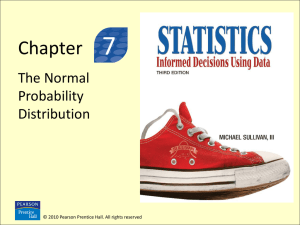
The Normal Distribution
© 2010 Pearson Prentice Hall. All rights reserved
© 2010 Pearson Prentice Hall. All rights
reserved
7-2
Relative frequency histograms that are symmetric and
bell-shaped are said to have the shape of a normal
curve.
© 2010 Pearson Prentice Hall. All rights
reserved
7-3
If a continuous random variable is normally distributed,
or has a normal probability distribution, then a relative
frequency histogram of the random variable has the
shape of a normal curve (bell-shaped and symmetric).
© 2010 Pearson Prentice Hall. All rights
reserved
7-4
© 2010 Pearson Prentice Hall. All rights
reserved
7-5
© 2010 Pearson Prentice Hall. All rights
reserved
7-6
© 2010 Pearson Prentice Hall. All rights
reserved
7-7
As we saw in the previous slide, if the mean of the distribution
changes, the center of the distribution shifts or translates across the
axis.
If the standard deviation changes, the distribution will either become
more spread out and the maximum density will decrease or the
distribution will become much more concentrated around the mean
and the maximum density will increase.
© 2010 Pearson Prentice Hall. All rights
reserved
7-9
EXAMPLE
Interpreting the Area Under a Normal Curve
The weights of giraffes are approximately normally distributed with mean μ =
2200 pounds and standard deviation σ = 200 pounds.
(a) Draw a normal curve with the parameters labeled.
(b) Shade the area under the normal curve to the left of x = 2100 pounds.
(c) Suppose that the area under the normal curve to the left of x = 2100
pounds is 0.3085. Provide two interpretations of this result.
(a), (b)
(c)
• The proportion of giraffes whose
weight is less than 2100 pounds is
0.3085
• The probability that a randomly
selected giraffe weighs less than
2100 pounds is 0.3085.
© 2010 Pearson Prentice Hall. All rights
reserved
7-10
© 2010 Pearson Prentice Hall. All rights
reserved
7-11
© 2010 Pearson Prentice Hall. All rights
reserved
7-12
© 2010 Pearson Prentice Hall. All rights
reserved
7-13
The table gives the area under the standard normal curve for
values to the left of a specified Z-score, zo, as shown in the
figure.
© 2010 Pearson Prentice Hall. All rights
reserved
7-14
EXAMPLE
Finding the Area Under the Standard Normal Curve
Find the area under the standard normal curve to the left of z = -0.38.
Area left of z = -0.38 is 0.3520.
© 2010 Pearson Prentice Hall. All rights
reserved
7-15
Area under the normal curve to the right
of zo = 1 – Area to the left of zo
© 2010 Pearson Prentice Hall. All rights
reserved
7-16
EXAMPLE
Finding the Area Under the Standard Normal Curve
Find the area under the standard normal curve to the right of Z = 1.25.
Area right of 1.25 = 1 – area left of 1.25
= 1 – 0.8944
= 0.1056 © 2010 Pearson Prentice Hall. All rights
reserved
7-17
EXAMPLE
Finding the Area Under the Standard Normal Curve
Find the area under the standard normal curve between z = -1.02 and z = 2.94.
In this case finding the area to the left of the z score of 2.94 is bigger than the
area we are concerned with, and the area to the left of the z score of -1.04
contains area that we are not concerned with.
To find the area we are interested in we will subtract the smaller area from the
larger, which will give us the area that is between them.
Area between -1.02 and 2.94 = (Area left of z = 2.94) – (area left of z = -1.02)
= 0.9984 – 0.1539
= 0.8445
© 2010 Pearson Prentice Hall. All rights
reserved
7-18
© 2010 Pearson Prentice Hall. All rights
reserved
7-19
EXAMPLE
Finding a z-score from a Specified Area
Find the z-scores that separate the middle 80% of the area under the normal curve
from the 20% in the tails.
Area = 0.8
Area = 0.1
Area = 0.1
z1 is the z-score such that the area left is 0.1, so z1 = -1.28.
z2 is the z-score such that the area left is 0.9, so z2 = 1.28.
© 2010 Pearson Prentice Hall. All rights
reserved
7-20
Notation for the Probability of a Standard Normal Random
Variable
P(a < Z < b)
represents the probability a standard
normal random variable is between
a and b
P(Z > a)
represents the probability a standard
normal random variable is greater
than a.
P(Z < a)
represents the probability a standard
normal random variable is less than a.
© 2010 Pearson Prentice Hall. All rights
reserved
7-21
For any continuous random variable, the probability of observing a specific
value of the random variable is 0. For example, for a standard normal
random variable, P(a) = 0 for any value of a. This is because there is no area
under the standard normal curve associated with a single value, so the
probability must be 0. Therefore, the following probabilities are equivalent:
P(a < Z < b) = P(a < Z < b) = P(a < Z < b) = P(a < Z < b)
© 2010 Pearson Prentice Hall. All rights
reserved
7-22
© 2010 Pearson Prentice Hall. All rights
reserved
7-23
EXAMPLE
Finding the Probability of a Normal Random
Variable
It is known that the length of a certain steel rod is normally
distributed with a mean of 100 cm and a standard deviation of
0.45 cm.* What is the probability that a randomly selected steel
rod has a length less than 99.2 cm?
99.2 100
P( X 99.2) P Z
0.45
P Z 1.78
0.0375
Interpretation: If we randomly selected 100 steel rods, we would expect about 4
of them to be less than 99.2 cm.
*Based
upon information obtained from Stefan
© 2010Wilk.
Pearson Prentice Hall. All rights
reserved
7-24
EXAMPLE
Finding the Probability of a Normal Random
Variable
It is known that the length of a certain steel rod is normally
distributed with a mean of 100 cm and a standard deviation of
0.45 cm. What is the probability that a randomly selected steel
rod has a length between 99.8 and 100.3 cm?
100.3 100
99.8 100
P(99.8 X 100.3) P
Z
0.45
0.45
P 0.44 Z 0.67
0.4186
Interpretation: If we randomly selected 100 steel rods, we would expect about 42
of them to be between 99.8 cm and 100.3 cm.
© 2010 Pearson Prentice Hall. All rights
reserved
7-25
© 2010 Pearson Prentice Hall. All rights
reserved
7-26
EXAMPLE
Finding the Value of a Normal Random Variable
The combined (verbal + quantitative reasoning) score on the GRE is normally
distributed with mean 1049 and standard deviation 189.
(Source: http://www.ets.org/Media/Tests/GRE/pdf/994994.pdf.)
What is the score of a student whose percentile rank is at the 85th percentile?
The z-score that corresponds to the 85th percentile is the z-score such that the
area under the standard normal curve to the left is 0.85. This z-score is 1.04.
x = µ + zσ
= 1049 + 1.04(189)
= 1246
Interpretation: 85% of all combined scores on the GRE will be lower than 1246, or that
the student has a score that is higher than 85% of everyone that took the GRE exam.
© 2010 Pearson Prentice Hall. All rights
reserved
7-27
EXAMPLE
Finding the Value of a Normal Random Variable
It is known that the length of a certain steel rod is normally distributed with
a mean of 100 cm and a standard deviation of 0.45 cm. Suppose the
manufacturer wants to accept 90% of all rods manufactured. Determine
the length of rods that make up the middle 90% of all steel rods
manufactured.
z1 = -1.645 and z2 = 1.645
Area = 0.05
Area = 0.05
x1 = µ + z1σ
= 100 + (-1.645)(0.45)
= 99.26 cm
x2 = µ + z2σ
= 100 + (1.645)(0.45)
= 100.74 cm
Interpretation: The length of steel rods that make up the middle 90% of all steel rods
manufactured would have lengths between 99.26 cm and 100.74 cm.
© 2010 Pearson Prentice Hall. All rights
reserved
7-28
A normal probability plot plots observed data
versus normal scores.
A normal score is the expected Z-score of the
data value if the distribution of the random
variable is normal. The expected Z-score of an
observed value will depend upon the number of
observations in the data set.
© 2010 Pearson Prentice Hall. All rights
reserved
7-29
© 2010 Pearson Prentice Hall. All rights
reserved
7-30
If sample data is taken from a population that is
normally distributed, a normal probability plot of the
actual values versus the expected Z-scores will be
approximately linear.
© 2010 Pearson Prentice Hall. All rights
reserved
7-31
EXAMPLE
Interpreting a Normal Probability Plot
The following data represent the time between eruptions
(in seconds) for a random sample of 15 eruptions at the
Old Faithful Geyser in California. Is there reason to
believe the time between eruptions is normally
distributed?
728
730
726
678
722
716
723
708
736
© 2010 Pearson Prentice Hall. All rights
reserved
735
708
736
735
714
719
7-32
The random variable “time between eruptions” is
likely not normal. © 2010 Pearson Prentice Hall. All rights
7-33
reserved
EXAMPLE
Interpreting a Normal Probability Plot
Suppose that seventeen randomly selected workers at a detergent factory were
tested for exposure to a Bacillus subtillis enzyme by measuring the ratio of forced
expiratory volume (FEV) to vital capacity (VC). NOTE: FEV is the maximum volume of
air a person can exhale in one second; VC is the maximum volume of air that a person
can exhale after taking a deep breath. Is it reasonable to conclude that the FEV to VC
(FEV/VC) ratio is normally distributed?
Source: Shore, N.S.; Greene R.; and Kazemi, H. “Lung Dysfunction in Workers Exposed to Bacillus subtillis Enzyme,” Environmental Research,
4 (1971), pp. 512 - 519.
© 2010 Pearson Prentice Hall. All rights
reserved
7-34
It is reasonable to believe that FEV/VC is normally
distributed.
© 2010 Pearson Prentice Hall. All rights
reserved
7-35







